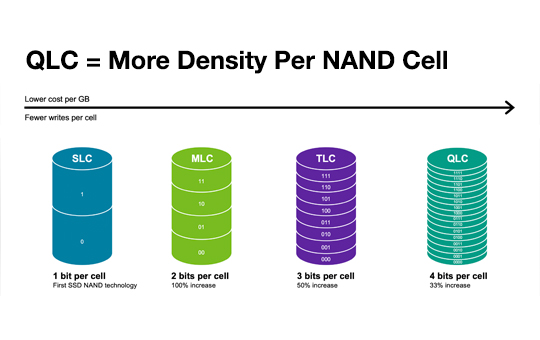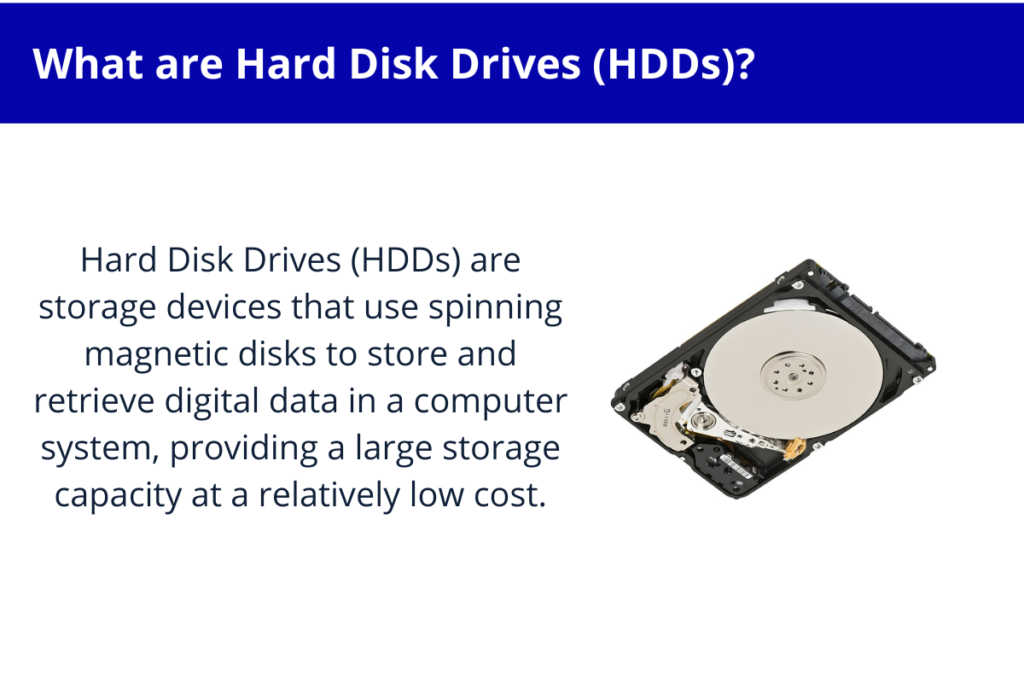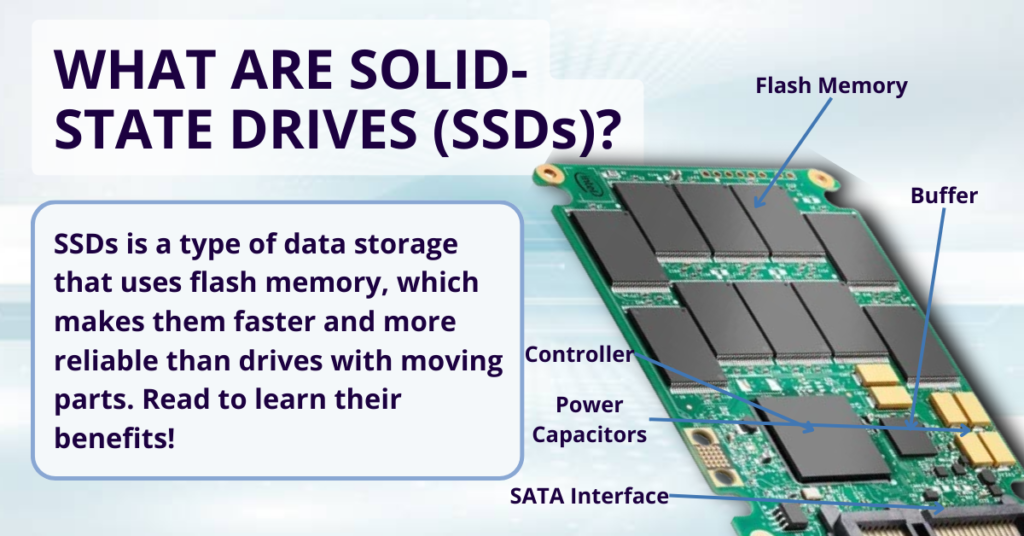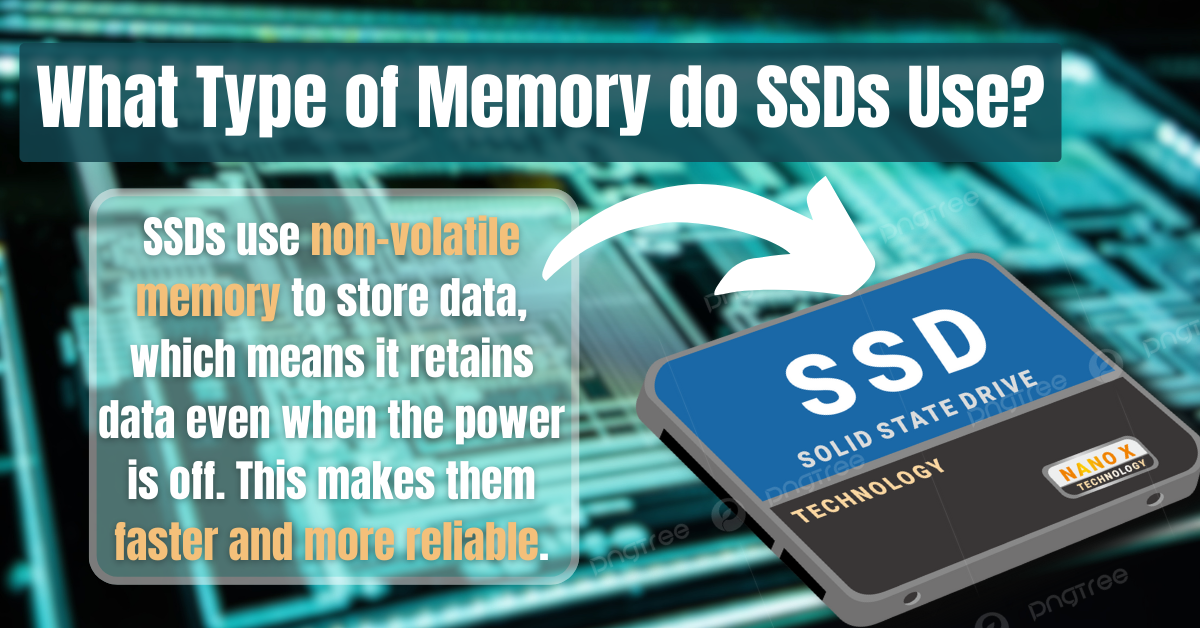What Type of Memory do SSDs Use? Are you curious about what makes your computer be quicker than before?
Solid-state drives (SSDs) are a key reason, they use a type of memory called NAND flash memory to store all your data.
This article will guide you through the simple concepts of what SSDs use to make everything from loading games to starting your computer lightning fast.
Keep reading, and let’s make sense of it together! What Type of Memory do SSDs Use?
Table of Contents
Key Takeaways
- SSDs use NAND flash memory to store data, making them faster and more reliable than hard drives with moving parts.
- They can retain information without power thanks to their non-volatile memory and come in various types like SLC, MLC, and TLC.
- SSDs are constructed with controllers that manage data storage efficiently and have interfaces like SATA and NVMe for quick data transfer.
- Unlike HDDs, SSDs do not suffer from mechanical wear over time, leading to a longer lifespan and less risk of failure.
Understanding Solid-State Drives (SSDs) – What Type of Memory do SSDs Use?
Solid-State Drives (SSDs) use non-volatile memory to store data, which means it retains data even when the power is off. SSDs are faster and more reliable than the other popular data storage type, traditional hard disk drives (HDDs).
Definition and explanation of SSDs
Solid-state drives (SSDs) are storage devices that use semiconductor-based memory to save your data. Unlike hard disk drives (HDDs), SSDs don’t have moving parts, which makes them faster and more reliable.
They store data on flash memory, which means they can keep your files safe even when you turn off your computer. This type of storage is known for its fast boot and load times, making everything from starting up your computer to opening apps much quicker.
SSDs come in different types, including single-level cells (SLCs) that store one bit per cell, multi-level cells (MLCs) that can hold two bits per cell, and triple-level cells (TLCs) with the ability to store three bits per cell.
The most common type of flash memory used in SSDs is NAND flash memory because it offers a good balance of speed, durability, and cost-effectiveness. With this technology, an SSD can instantly access any data without having to move mechanical parts around like HDDs do.
This results in nearly instant performance improvements for loading software or accessing files you’ve saved on your device.
And now, What Type of Memory do SSDs Use?

Source Image: Understanding SSD Endurance | SuperSSD
How do SSDs work?
Now, let’s dive into how SSDs work. Solid-state drives (SSDs) use NAND flash memory for reading and writing data digitally. They are semiconductor-based storage devices that provide persistent data storage without any moving parts, unlike traditional hard disk drives (HDDs).
SSDs can deliver nearly instant boot and load times due to their use of flash memory, which allows them to access data much faster than HDDs. These drives do not have to mechanically seek out data like HDDs do, contributing to their quicker performance.
NAND flash memory is the most popular type of memory used in SSDs; it typically uses single-, multi-, or triple-level cells, with each cell capable of holding one or more bits of data at a time.
This technology underpins the remarkable speed and efficiency that solid-state drives offer compared to traditional mechanical hard drives.
By using these advanced technologies like NAND flash memory, SSDs present an efficient solution for your digital storage needs.
Types of SSD Non-Volatile Memory
Here is the answer to What Type of Memory do SSDs Use? SSDs use NAND Flash Memory, which is a type of non-volatile memory. Other persistent memory technologies are also utilized in SSDs.
NAND Flash Memory
NAND flash memory is the go-to choice for SSDs. It’s a specific type of non-volatile memory that allows data to be stored persistently. NAND flash is what gives SSDs their speedy performance and reliability, as it can read and write data digitally without any moving parts involved.
This technology enables nearly instant boot and load times in SSDs, making them popular for various computer storage needs. NAND flash comes in different variations like single-, multi- and triple-level cells, with each offering varying levels of data capacity per cell.
SSDs are widely known for their use of this NAND flash memory which ensures fast, reliable, and durable storage capabilities. They’re a solid-state drive essential – providing top-notch semiconductor-based storage without mechanical components found in traditional hard drives (HDDs).
These attributes make NAND flash-equipped SSDs an ideal choice for those seeking persistent and efficient digital storage solutions.

Other persistent memory technologies
Other persistent memory technologies include NOR flash memory, which is used in some SSDs and provides fast read speeds. Unlike NAND flash, NOR can perform random access at the byte level, making it suitable for executing code directly from the memory.
Another emerging technology is 3D XPoint, a non-volatile memory that offers higher endurance and lower latency than NAND flash. These technologies contribute to the ongoing advancements in solid-state storage, offering improved performance and reliability for your data storage needs.
Moving on to “Comparison with Other Technologies” let’s explore how SSDs stack up against hard disk drives (HDDs).
Challenges and limitations of NAND Flash Memory
NAND Flash Memory faces certain challenges and limitations. One key issue is that NAND memory cells degrade over time due to repeated use, leading to a decrease in performance and lifespan.
Another challenge is the limited number of write cycles each cell can endure before it becomes unreliable or fails completely. Furthermore, as NAND flash memory technology advances, packing more data into smaller spaces increases the likelihood of errors and reduces overall durability.
Despite these challenges, ongoing developments continue to improve the reliability and longevity of NAND flash memory in SSDs.
Moving on to comparing SSDs with other technologies…
Comparison with Other Technologies
SSDs outperform HDDs and memory cards in speed and reliability. They’re more durable than HDDs and offer higher storage capacity than memory cards.
Hard Disk Drives (HDDs)
When it comes to hard disk drives (HDDs), they use spinning magnetic disks to store and retrieve digital information. Unlike SSDs, HDDs have moving parts such as a spinning platter and mechanical arm that reads and writes data.
The speed of an HDD is measured in RPM (revolutions per minute). Although HDDs are less expensive for higher storage capacity, they are slower in terms of data access compared to SSDs.
In addition, the lifespan of an HDD can be affected if the device experiences physical damage or wear over time due to its mechanical components. Moreover, because of their moving parts, HDDs are more susceptible to failure when exposed to shocks or vibrations.
Therefore, while HDDs may offer cost-effective high storage capacities for certain uses like large file storage servers; their overall speed and durability are surpassed by the solid-state drives’ non-mechanical design.
If you use HDDs for your RAID setup, you should check this RAID Calculator to maximize your data storage strategy performance.

Memory Cards
Memory cards are small, portable storage devices used in various electronic devices like cameras and smartphones. They have non-volatile memory that retains data even when the power is off.
Common types include SD (Secure Digital) cards, microSD cards, and CompactFlash cards. They use NAND flash memory to store data and come in different capacities ranging from a few gigabytes to several terabytes.
Memory cards provide convenient, removable storage for your digital files such as photos, videos, documents – making it easy to transfer them between devices.
Memory cards like SD and microSD are widely used in digital cameras and smartphones for expanding storage or transferring data between devices. These compact storage solutions are essential for keeping your digital files safe and easily accessible on-the-go.
SSD Failure and Reliability
Now, let’s talk about the reliability of solid-state drives (SSDs). SSDs are known for their durability and fast performance. They lack moving parts, making them less prone to mechanical failure.
As a result, SSDs tend to have higher reliability compared to traditional hard disk drives (HDDs). The use of NAND flash memory in SSDs contributes to this reliability due to its ability to retain data even without power.
This means that your data is safer from corruption and loss. Moreover, the absence of mechanical components reduces the risk of wear and tears over time, ensuring a longer lifespan for your SSD.
It’s essential to note that while SSDs offer high reliability, like any electronic device, they can still experience failures. However, technological advancements continue to improve SSD reliability further by enhancing error correction capabilities and implementing wear-leveling algorithms.
These measures help prolong the lifespan of an SSD while maintaining robust performance throughout its usage.
In conclusion, solid-state drives (SSDs) provide exceptional reliability and durability due to their construction with no moving parts and their use of NAND flash memory technology.
How Are SSDs Made?
SSDs are made with a controller, memory, cache or buffer, and host interface. Read on to explore more about the making of SSDs.

Controller
The controller in an SSD manages data storage and retrieval. It coordinates the flow of information between the host computer and the memory chips, ensuring efficient operation. The controller also executes error correction, wear leveling, and garbage collection to maintain the integrity and longevity of the SSD.
Through its functions, it contributes to enhancing the speed and reliability of data access within the solid-state drive.
SSDs utilize controllers to efficiently manage data storage as well as enhance overall performance. These components play a crucial role in facilitating seamless communication between your computer and the flash memory inside your SSD while optimizing various operations like error correction, wear leveling, and garbage collection for sustained functionality.
Memory
SSDs use NAND flash memory for persistent data storage. This type of memory allows SSDs to read and write data digitally, which contributes to nearly instant boot and load times. Unlike traditional hard disk drives (HDDs), SSDs do not have moving parts.
Instead, they rely on semiconductor-based storage devices with NAND flash memory, making them faster and more reliable for storing your data.
Now let’s explore how these solid-state drives are made.
Cache or buffer
SSDs use a cache or buffer to improve performance. This temporary storage holds frequently accessed data, allowing for faster access and retrieval. The cache or buffer is usually made of DRAM (Dynamic Random-Access Memory) and works alongside the SSD’s controller to optimize data transfer speeds, enhancing overall system responsiveness.
This efficient use of cache or buffer helps enhance the speed and efficiency of data access in SSDs, ensuring quicker loading times and smoother performance for your computing needs.

Host interface
The host interface connects the SSD to your computer. It determines how fast data can be transferred between the SSD and the rest of your system. Common interfaces include SATA, PCIe, and M.2.
The latest NVMe interface provides much higher data transfer rates compared to traditional SATA connections, significantly boosting overall system performance.
SSD storage has moved beyond being just a buzzword in recent years – it’s becoming an essential part of computing technology for both personal and professional use due to its benefits such as fast boot times, reduced power consumption, and increased durability when compared to traditional hard drives.
With technologies like NVMe pushing data transfer speeds even further on these systems now boasting over 7GB/s reads with costs that continue to decrease rather than increase like most products do making them more accessible too!
Quality and performance
Now, let’s shift our focus to the quality and performance of SSDs. The use of flash memory in SSDs results in faster boot times and data access compared to traditional hard drives.
They are more durable due to the absence of moving parts, making them less susceptible to physical damage. Additionally, SSDs consume less power than HDDs, contributing to better energy efficiency for your device.
The NAND flash memory used in SSDs also facilitates faster read and write speeds, providing a smoother experience when multitasking or running demanding applications. This improved performance translates into quicker file transfers and reduced loading times for programs and games stored on an SSD, giving you a seamless computing experience.
Conclusion
What Type of Memory do SSDs Use?
So there you have it, SSDs use different types of memory such as single-, multi-, and triple-level cells. They rely on flash memory to read and write data digitally. Unlike traditional hard drives, SSDs have no moving parts, providing faster performance and nearly instant boot times.
NAND flash memory is the go-to choice for most SSDs, ensuring quick access to your data without mechanical delays. With this simple breakdown, you can now grasp how SSDs store your precious files in a flash!

FAQs – What Type of Memory do SSDs Use?
1. What type of memory do solid state drives (SSDs) use?
Solid state drives use a type of nonvolatile memory called semiconductor storage, which is different from the random access memory (RAM) used in computer hardware.
2. How does SSD storage compare to hard drive HDD storage?
Unlike the hard drive HDD that uses mechanical parts for data storage, SSDs rely on electronic storage methods making them faster and more reliable as a solid-state storage device.
3. Are SSDs considered persistent storage devices?
Yes, since they retain information even when power is turned off, SSDs are classified as persistent or nonvolatile memory devices within the realm of computer memory.
4. Is there a difference between RAM and the memory used in an SSD?
Absolutely! While both are part of computer hardware, RAM is temporary and volatile while the semiconductor storage used in solidstate hard drives like SSDs retains data even without power.
5. Can you explain what ‘solidstate’ means in simple terms?
‘Solidstate’ refers to electronic systems made entirely from semiconductors rather than using mechanical parts; hence why we refer to these types of drives as ‘solidstate’.





